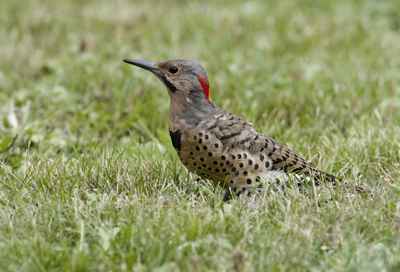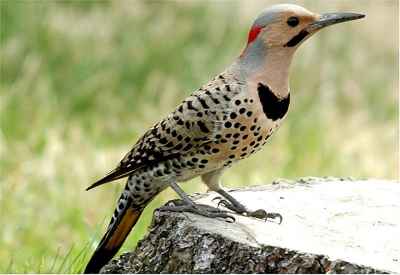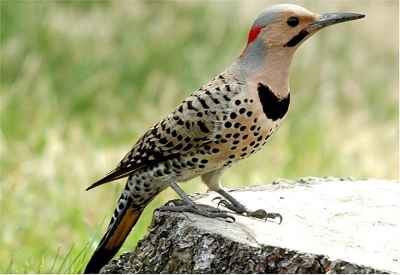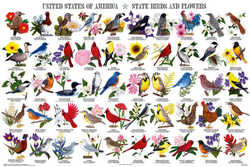Alabama Symbols
Alabama State Bird
Yellowhammer (Northern Flicker)

(Colaptes auratus, Linnaeus)
Adopted on September 6, 1927.
The Yellowhammer, (Colaptes auratus, Linnaeus,) a flicker, was adopted as Alabama official state bird on September 6, 1927. The bill to create a state bird was introduced in the 1927 legislature by Representative Thomas E. Martin, of Montgomery County. It was approved the same day the goldenrod became the state flower.
The Yellowhammer has been a symbol of Alabama since the Civil War. (The "Yellowhammer State" is one of Alabama's nicknames). The Yellowhammer's colors of gray and yellow were said to resemble the uniform of a Confederate cavalryman, and an Alabama regiment of the Confederate Army wore yellowhammer feathers in their hats. These stories and the widespread abundance of the species led to the yellowhammer's selection as Alabama's state bird.
Alabama State Bird: Yellowhammer

The back of the male of the common flicker is a gray-brown color with broken black bars on the body feathers and with the yellow shafts of the flight feathers partly visible. The rump patch is white and the two-pointed tail is mainly black. The crown and back of the neck is gray with a red band at the nape. The cheeks are pinkish-buff with a black "moustache" and bib below the chin on the throat. The under-parts of the flicker are creamy with many, irregular black spots. The undersides of the wings and tail are bright yellow. The female differs from the male in that she does not have the "moustache". Both sexes have gray legs, a dark gray bill and dark brown eyes. The talons are quite sharp. This helps the bird to easily perch on vertical tree trunks.
The Common Flicker walks on the ground more than other woodpeckers, and has an awkward hopping movement. It is often seen feeding on lawns and is, perhaps, the most common woodpecker of the city and suburban areas.
Common Names of the Northern Flicker
This member of the woodpecker family, also called a flicker (Colaptes aratus,) Yellowhammer, Flicker, Yellow-shafted Flicker, Southern Flicker, or Northern Flicker got its name from the way it hammers trees with its beak and the flash of yellow it displays on the underside of its wings. Correct common name of the American Ornithologists Union: Northern Flicker.
Characteristics of the Northern Flicker
Nesting and Reproduction
The female lays 6 to 10 white colored eggs in its nest. They usually nest in holes in dead trees or fence posts. One egg is laid each day until the clutch is completed. Incubation of the eggs requires about 17 days and the nestlings are ready to fly (or fledge) about 3 weeks to a month after hatching.
Food
Flickers eat more ants than any other American bird. They also eat grasshoppers, crickets, berries, nuts and seeds. They especially like the berries of poison ivy.
Life Span
The relatively large egg clutch indicates a fairly short lived bird. A single band return of just over three years may not be an unreasonable average age. However there is insufficient data to substantiate this as an average life span.
Predator Agents
This species of wild bird is subject to predation from owls, hawks and tree climbing snakes. It is also subject to attack by these and mammalian predators when feeding on the ground. However, predation poses no threat to the species.
Management
As with all song birds, the common flicker is protected by provisions of the Migratory Bird Treaty Act entered into by Mexico, Canada and the United States. Feeding habits of the flicker make it reasonably easy to produce food items that are attractive. Production of berries, nuts and seeds will attract other types of birds also. Since this bird will use a nest box for nesting, it lends itself to this phase of management by providing such sites. A box for a flicker should have a 7 x 7 inch floor, be 16 to 18 inches deep and have a 2 1/2 inch diameter entrance located 2 inches from the top. It should be located 6 to 20 feet above ground. The bottom should be covered with wood chips to a depth of 2 inches.
History of the Yellowhammer

The common flicker is the state bird of Alabama. Alabama has been known as the "Yellowhammer State" since the Civil War. The yellowhammer nickname was applied to the Confederate soldiers from Alabama when a company of young cavalry soldiers from Huntsville, Alabama under the command of Rev. D.C. Kelly, arrived at Hopkinsville, Kentucky, where Gen. Forrest's troops were stationed. The officers and men of the Huntsville company wore fine, new uniforms, whereas the soldiers who had long been on the battlefields were dressed in faded, worn uniforms. On the sleeves, collars and coattails of the new cavalry troop were bits of brilliant yellow cloth. As the company rode past Company A , Will Arnett cried out in greeting "Yellowhammer, Yellowhammer, flicker, flicker!" The greeting brought a roar of laughter from the men and from that moment the Huntsville soldiers were spoken of as the "yellowhammer company." The term quickly spread throughout the Confederate Army and all Alabama troops were referred to unofficially as the "Yellowhammers."
When the Confederate Veterans in Alabama were organized they took pride in being referred to as the "Yellowhammers" and wore a yellowhammer feather in their caps or lapels during reunions.
Alabama Law
The law designating the yellow hammer as the official Alabama state bird is Section 1-2-7 of Chapter 2 of Title 1 of the Code of Alabama, 1975.
TITLE 1.
Chapter 2 - STATE SYMBOLS AND HONORS.
Section 1-2-7 - State bird.
The bird commonly called the yellow-hammer is hereby designated the state bird.
(Acts 1927, No. 542, p. 628; Code 1940, T. 55, §7.)
Taxonomic Hierarchy: Yellowhammer (Northern Flicker)
Kingdom: Animalia (animal)
Phylum: Chordata (chordates)
Class: Aves (birds)
Order: Piciformes (woodpeckers, toucans, puffbirds and jacamars)
Family: Picidae (woodpeckers, piculets, wrynecks and sapsuckers)
Subfamily: Picinae (woodpeckers, sapsuckers)
Genus: Colaptes (woodpeckers)
Species: Colaptes aurutus (Linnaeus, 1758)
Subspecies: Colaptes aurutus aurutus (Linnaeus, 1758)
Binomial Name: Colaptes aurutus
Taxonomic Serial Number: 178154








